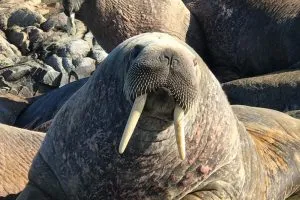Walruses (Odobenus rosmarus) are an iconic marine mammal species, particularly because of their large size and their mustaches and tusks. Being an Arctic dwelling species, they have many features which allow them to survive.
In this article, we will look at 16 interesting facts about walruses. Sometimes they are misunderstood, so these facts will help you understand them better!
- 1. There is more than one type of walrus
- 2. Wild walruses are only found in the Northern Hemisphere
- 3. Walruses will have never seen a penguin in the wild
- 4. Walruses spend two-thirds of their lives underwater
- 5. Walruses only have a handful of predators
- 6. Walruses can live up to 40 years old
- 7. You can tell how old a walrus is by looking at its teeth
- 8. Walruses can be up to 19 times as heavy as a human
- 9. Walruses can swim as fast as 35km/h
- 10. Walruses do not use their tusks to kill their prey!
- 11. Walruses use their whiskers and mustache to 'see' underwater
- 12. Walruses can be trained to perform tricks!
- 13. Walruses love to eat clams and other invertebrates!
- 14. All walruses have tusks!
- 15. Walruses are still hunted by humans to-date.
- 16. Walruses are more clever than you may think.
1. There is more than one type of walrus
Walruses are maine mammals that can be broken down into two main types (known as sub-species).
The two main sub-species of walruses are the Altantic walrus (Odobenus rosmarus rosmarus), and the Pacific Walrus (Odobenus rosmarus divergens)1 (source: Wikipedia).
There is also ongoing research into a potential third sub-species of walrus2 (sources: BBC and C. Linqvist, et al, Zoologica Scripta, Vol. 38, No. 2, pp113–127, 2009).
2. Wild walruses are only found in the Northern Hemisphere
In their wild habitat, walruses only live in the Northern Hempisphere, in the arctic and sub-arctic regions.
Atlantic walruses live in the Atlantic Ocean from Canada to Greenland. Pacific walruses live in the Pacific Ocean, in the northern seas above Russia and Alaska. This marks the southernmost part of its range; southeast Unalaska Island3 (source: IUCN).
See our full article for a full map showing where walruses are found.
3. Walruses will have never seen a penguin in the wild
People are always asking us whether walruses eat penguins. These flightless sea birds would surely be easy picking for the mighty walrus, right?
Well, not quite. We know that walruses are found in the northern hemisphere4 (source: IUCN), but this is a long way from penguins which are only found in the southern hemisphere5 (source: P. Dee Boersma & P.G. Borboroglu, Penguins: Natural History and Conservation, 2015).
This means that there is no overlap between where they are naturally found!
4. Walruses spend two-thirds of their lives underwater
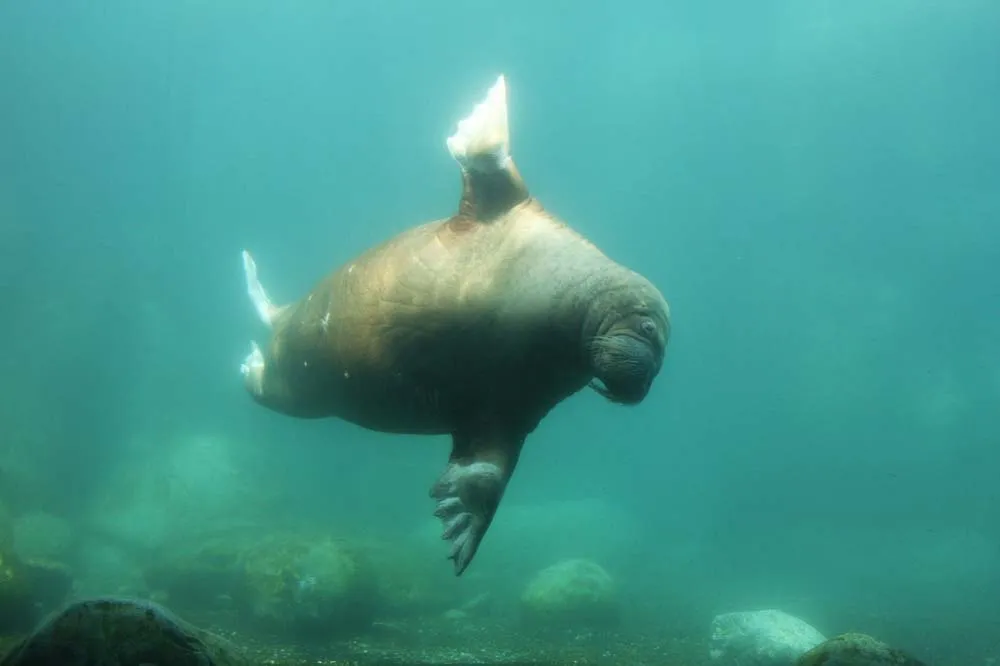
Walruses spend an estimated two-thirds of their life underwater6 (source: Seaworld). During this time, they mostly sleep, mate, travel, and forage for food.
For the other one-third of their life, walruses live out of the water. Walruses prefer to ‘haul out’ which is when they rest such as between foraging sessions7 (source: E. Grande, et al., Journal of Experimental Marine Biology and Ecology, Vol. 500, pp.89-99, 2018). Another reason to escape the water is to avoid predators8 (source: WWF).
5. Walruses only have a handful of predators
Walruses do not have many predators. Due to the large size of a walrus, it is often not worth the energy to fight a walrus.
However, when food is scarce, there are a couple of marine mammals which are brave and strong enough to hunt a walrus. The main predators of walruses are orcas, polar bears, and humans9 (source: N.V. Kryukova, et al, Biology Bulletin, Vol. 39, pp.768–778, 2012).
6. Walruses can live up to 40 years old
The walrus is a long-living marine mammal, it’s estimated that the lifespan of a walrus in the wild is around 40 years old.
Although some animals will live for longer in captivity, this is not the case with a walrus as their lifespan is reduced to 20-30 years in captivity10 (source: F.H. Fay, Mammalian Species, Vol. 238, pp.1-7, 1985).
Although walruses in captivity are protected from threats such as polar bears and orcas, there are other potential problems. One problem which can affect the lifespan of a walrus in captivity is tusk infections11 (sources: University of Michigan and Zoodent International).
7. You can tell how old a walrus is by looking at its teeth
Scientists can find out the age of a walrus by analyzing its teeth. This is possible as when walrus teeth grow, the dental material creates “growth rings” – similar to how a tree is aged! It is usually the cheek tooth of a walrus that is analyzed12 (source: Seaworld).
8. Walruses can be up to 19 times as heavy as a human
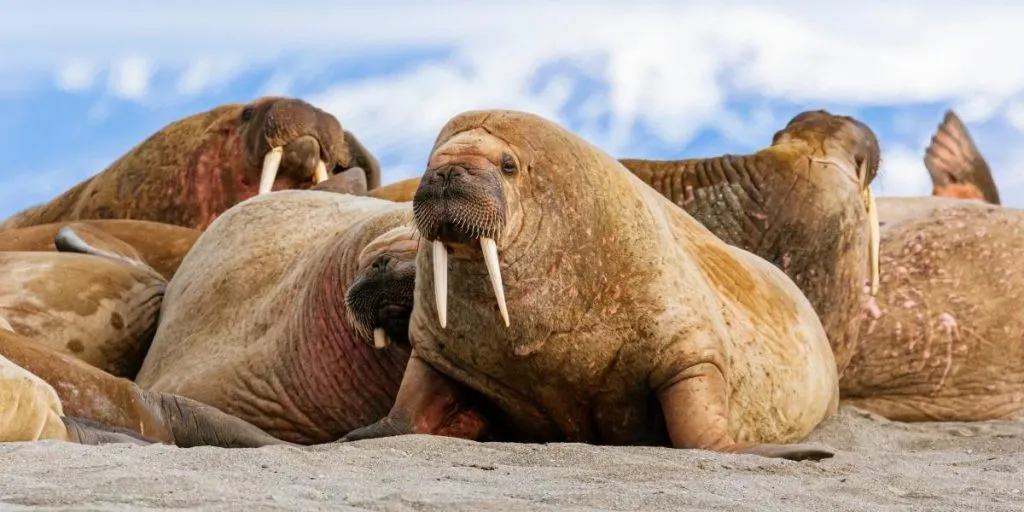
Walruses are much bigger than you might think. The largest walruses (adult male Pacific walruses) can exceed 2,000kg (4,400lb), and reach 2.7 to 3.6 m (9-12 ft) tall. Male walruses are generally bigger than females, on average. Also, pacific walruses are generally larger than Atlantic walruses.
Generally speaking, both walrus subspecies can grow larger than humans13 (source: F.H. Fay FH, “Odobenus rosmarus”. Mammalian Species. Vol. 238, No.24, pp.1–7, 1985 and Healthline).On average, an adult male human in the US weighs around 90 kg (198 lb) whereas an adult male Pacific walrus will weigh between 800 – 1700kg (1,800 – 3700 lbs). This means that walruses can be around 19 times heavier than humans.
For more size comparisons, see our dedicated article about the size of walruses.
9. Walruses can swim as fast as 35km/h
Although they are known to be very heavy, Walruses can swim very fast underwater. Walrus can travel up to 21.7 mph (35 km/h) in the water, at an average speed of 4.3 mph (7 km/h)14 (source: Seaworld).
They can travel this quickly because of the way their hind flippers are used to propel them through the water.
This is different to how they are used on land when they rotate them so that they can travel on all fours. This is why they move much slower on and compared to in the water.
10. Walruses do not use their tusks to kill their prey!
Walrus tusks are very important for their survival in the Arctic regions15 (source: WWF). One of the main uses of the tusks is to help them ‘haul out’16 (source: National Geographic). This is where the walrus uses its tusks to pull its body out of the water and onto sea ice or landmass.
Another use of their tusks is to keep breathing holes open in the ice – this allows them to breathe in between dives.
Walruses also use their tusks during the conflict. This conflict can include defending its territory or protecting itself against predators or other walruses. Female walruses have been observed to use their tusks to defend their calves17 (source: WWF). Walruses do not use their teeth to kill prey18 (source: F.H. Fay, North American Fauna, Vol. 74, No. 74, pp.1–279, 1982).
Due to their size and their tusks, walruses are dangerous animals. Although they won’t go out of their way to hunt humans, walrus encounters have resulted in damaged vessels and human fatalities.
11. Walruses use their whiskers and mustache to ‘see’ underwater
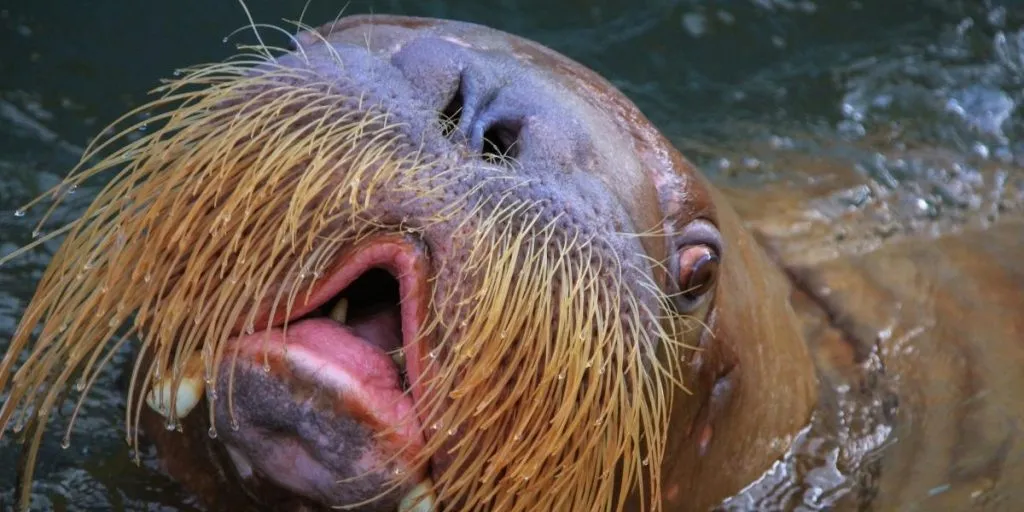
Walruses have some of the most sensitive whiskers of all mammals. They use their whiskers to detect vibrations within the water19 (source: R.A. Kastelein, Encyclopedia of Marine Mammals (2nd ed), pp.1212-1217, 2009).
The scientific word for whiskers and mustache in mammals other than humans is vibrissae. They play a particularly important role in marine mammals which forage in deep water20 (source: Wikipedia).
Vibrissae are also used to help identify objects, including their size, shape, and texture. Their whiskers help them detect objects, whilst their mustach helps them identify the object21 (source: R.A. Kastelein, Aquatic Mammals 14(3), pp.123-133, 1988).
Interested to learn more about their Vibrissae? See our article on why walruses have whiskers and a mustache to find out what they are made of and how they work.
12. Walruses can be trained to perform tricks!
Walruses kept in captivity can be taken care of by specialized mammal/animal behavior experts. These tricks are often the natural abilities of a walrus, which are encouraged by a food reward.
An example of one of these “tricks” is making various noises on a cue. Another example is interaction with toys which are provided by zookeepers, to encourage natural foraging behaviors.
Walruses also perform various physical responses including head nodding, lifting their flippers, and moving in and out of the water on demand22 (source:YouTube).
13. Walruses love to eat clams and other invertebrates!
Walruses are carnivorous so they only eat meat. The preferred prey of a walrus is clams. However, they are not picky eaters23 (source: How Stuff Works).
If mollusks are not easily available, walruses supplement their diet with other organisms. The other organisms which walrus eat include crabs, shrimp, worms, snails, sea cucumbers, and squid24 (source: WWF).
They like to eat many of these bottom-dwelling (benthic) invertebrates because they have soft tissue. If walruses are very hungry and their preferred food is not available, they eat seabirds, seals and fish. In captivity, walrus are fed predominantly on clams.
14. All walruses have tusks!
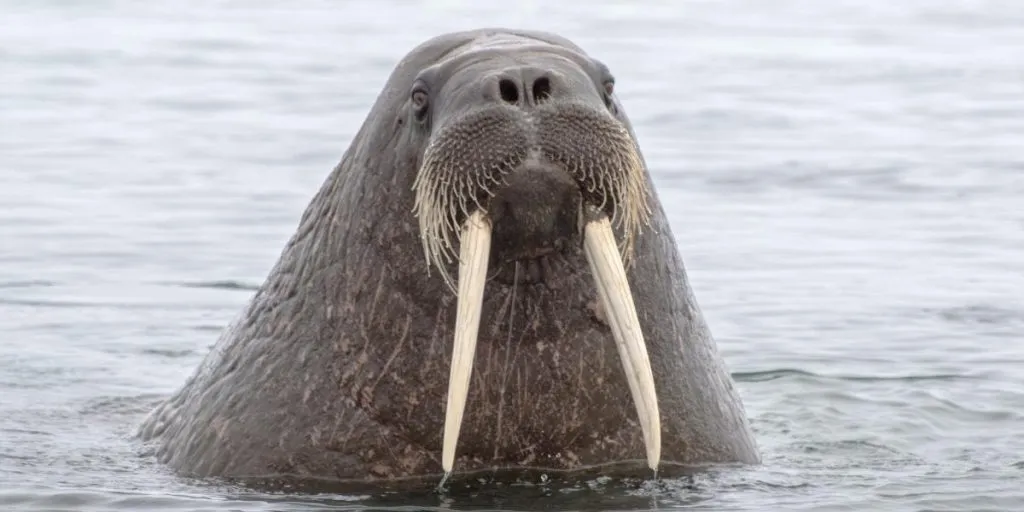
Both male and female walruses, from both subspecies, have tusks25 (source: National Geographic).
Tusks are simply elongated canine teeth. These grow continuously throughout their life. Sometimes they grow too big for its tooth caps, and fall out26 (source: F.H. Fay, North American Fauna, Vol. 74, No. 74, pp.1–279, 1982)! But, walrus tusks grow back.
Some extinct walrus species may not have had teeth27 (source: R. Boessenecker, A new Early Pliocene record of the toothless walrus Valenictus, 2017). Find out more about this in our guide to walrus tusks.
15. Walruses are still hunted by humans to-date.
Walruses have been hunted for their blubber, hide, and tusks for the last 5,000 years28 (source: DEFRA).
There are some restrictions on the hunt of walrus, and the trade of products made from them, but there are still loopholes for certain uses.
Restrictions vary between and within countries29 (source: US Department of the Interior), and in some countries, it is still legal for Inuit communities to hunt them for subsistence30 (source: DEFRA).
16. Walruses are more clever than you may think.
Walruses are smart in the sense they are adaptable to various scenarios, understand how to best protect their young, and importantly know when NOT to fight – despite being one of the largest marine mammals with enlarged canine teeth. This highlights their emotional intelligence31 (source: The Polar Bear Program).
They also have an impressive range of vocalizations with various purposes. Walruses can be trained to make these noises on demand32 (source: YouTube).


![You are currently viewing 16 Tusk-Worthy Facts about Walruses [#7 Will Shock You]](https://polarguidebook.com/wp-content/uploads/2022/09/Walrus.jpg)
![Read more about the article How Fast Are Walruses? [On Land and Swimming]](https://polarguidebook.com/wp-content/uploads/2022/06/How-fast-are-walrus-300x150.jpg)
![Read more about the article How Big Are Walruses? [Size + Weight Compared to Humans]](https://polarguidebook.com/wp-content/uploads/2022/09/Walrus-Size-300x200.jpg)
